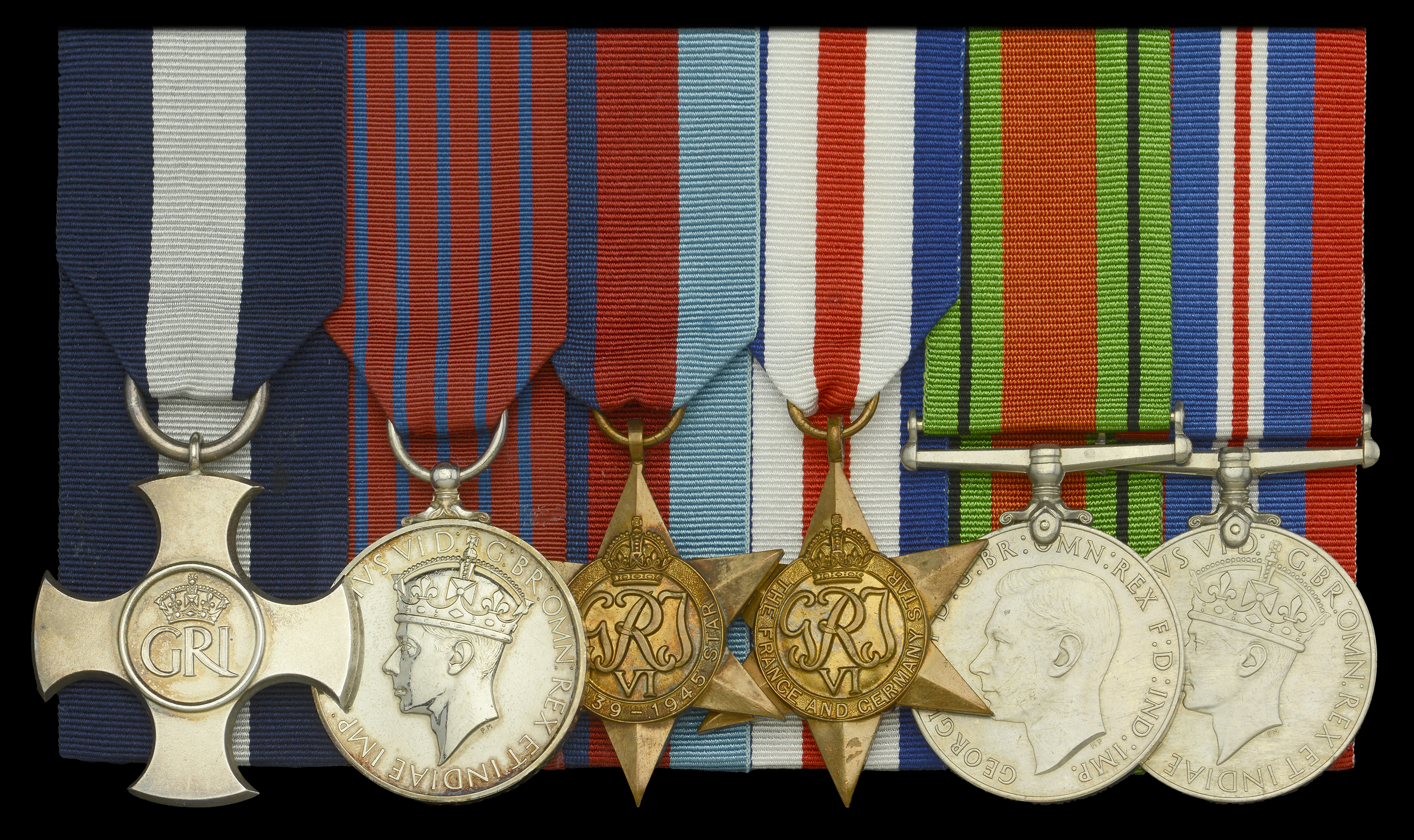The Second War bomb disposal operations D.S.C. and George Medal group of six awarded to Lieutenant-Commander D. Law, Royal Naval Volunteer Reserve: having diffused around 40 UXBs in the period 1940-42, he went on to carry out equally gallant work at Calais and Zeebrugge in October 1944, carrying out an examination of the lock-gates for booby-traps at the latter place when enemy troops were positioned just 40 yards away Distinguished Service Cross, G.VI.R., the reverse hallmarked London 1942, officially dated ‘1945’ and privately engraved ‘Lt. Cdr. David Law, R.N.V.R.’ George Medal, G.VI.R., 1st issue (Lieut. David Law, R.N.V.R.); 1939-45 Star; France and Germany Star; Defence and War Medals, mounted court-style for display, good very fine and better (6) £6,000-£8,000 --- Importation Duty This lot is subject to importation duty of 5% on the hammer price unless exported outside the UK --- --- Provenance: Dix Noonan Webb, September 2006. G.M. London Gazette 28 April 1942: ‘For gallantry and undaunted devotion to duty.’ The original recommendation states: ‘This officer has dealt with 39 bombs, one of which was embedded in six feet of concrete with only the filler-cap showing. The bomb could not be withdrawn owing to the lack of purchase. Also the existence, close by, of important installations, made it impossible to destroy it on the spot. It was essential to remove it as soon as possible, the safety period therefore having to be ignored. Everyone was sent away while Lieutenant Law gently chipped a hole in the concrete with the least possible vibration and scraped out the sand underneath with his hand until he found the fuse. This he discharged, but then had to remove it by hand as it was not possible to rig up remote control apparatus. He tested it roughly for spring in case a Zus. 40 booby-trap was present and then removed the fuse. Afterwards the hole was made long enough to take out the bomb. A bomb had fallen into the bunker of a ship. A channel was cut through the coal to the spot where it was assumed that the bomb lay. This was between 8-12 feet down and 16 feet in. The tail of the bomb was found and gradually the fuses were exposed and discharged. The bomb was hoisted out. The flooded engine room could then be pumped out and a second bomb was found with the fuse downwards. Lieutenant Law, by careful use of wedges and a crowbar, turned the bomb until he could get at the fuses and discharge them.’ D.S.C. London Gazette 16 January 1945: ‘For gallantry and devotion to duty in operations leading to the capture of Calais and Zeebrugge.’ The original recommendation states: Lieutenant-Commander Law was one of two Bomb Safety Officers attached to the Port Reconnaissance Party which entered Calais on 1st October. Information was received from Prisoners of War that the enemy had p[laced demolition charges in the Main Control Bunker (concrete shelter) and it was found that the bunker was on fire inside. Lieut.-Comdr. Law, with his assistant Sub-Lieut. Swain, entered the bunker, wearing oxygen breathing apparatus and succeeded in extinguishing the fire and neutralising seven 500-lb charges which were already hot. On 18th October, prior to the capture of Zeebrugge, this Officer, with the same companion, undertook to obtain information regarding the state of the lock-gates at this port. At the time, the German line was about 40-yards east of the lock-gates and the British line was 800-yards west of them. The two officers succeeded in making their way under cover of darkness to a suitable position where they waited until daylight and were able to make the necessary detailed observation of the lock and gates and to establish that any attempt to capture the position intact was pointless. Lieut.-Comdr. Law showed courage of a high order, initiative and devotion to duty.’ David Law, a native of Clydebank who graduated from Glasgow University prior to the War, was attached to the Director of Unexploded Bomb Department (D.U.B.D.) from as early as December 1940, so we may be sure that many of the 39 bombs referred to in his G.M. recommendation were very much of the “Blitz” period. But his gallant deeds in a ship’s bunker - those cited in the same recommendation - were actually enacted on the 2 October 1941, when he was called to the S.S. Sturdee Rose at Milford Haven, which merchantman had put in to port after being attacked by a brace of prowling He. 111s. He was duly awarded the G.M., which decoration he received at an investiture held on 30 June 1942. Law was serving in the Torpedo and Mining Department by the time of his subsequent acts of gallantry at Calais and Zeebrugge in October 1944, and was invested with his D.S.C. at Holyrood Palace on 27 September 1945, shortly before his release from the R.N.V.R. Sold with a quantity of original documentation and artefacts, including his commission warrant for the rank of Temporary Sub-Lieutenant, R.N.V.R., dated 15 January 1943, with seniority from 29 September 1940; a superb album of copied photographs taken from the recipient’s original archive (approximately 40 images), the whole detailing the events of a UXB incident in the Grimsby area, and fully captioned with explanatory notes; an unused “Unexploded Bomb Report” card and a copy of the Civil Defence training pamphlet Notes On The Detection and Reporting of Unexploded Missiles (H.M.S.O., 1943); Admiralty letter notifying him of the award of his D.S.C., dated 20 January 1945, with three others relating to investiture arrangements; and the artefacts including his R.N.V.R. uniform epaulettes and cap badge, cloth “UXB” sleeve badge, wooden R.N. B.D.S. (Royal Navy Bomb Disposal Section) wall-plaque and wartime White Ensign, the leading edge ink-inscribed, ‘D. Law, R.N., B.D.S.’










